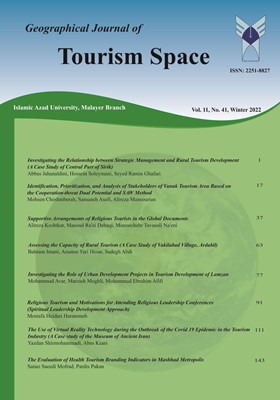Assessing the Capacity of Rural Tourism (Case Study: Vakilabad Village, Ardabil)
Subject Areas :
Bahram Imani
1
*
![]() ,
arastoo yari hesar
2
,
sadegh abdi
3
,
arastoo yari hesar
2
,
sadegh abdi
3
1 - Associate Professor of Geography and Rural Planning, University of Mohaghegh Ardabili, Ardabil, Iran
2 - Associate Professor of Geography and Rural Planning, University of Mohaghegh Ardabili, Ardabil, Iran
3 - M.A., Geography and Rural Planning, University of Mohaghegh Ardabili, Ardabil, Iran
Keywords: Ardabil City, Rural tourism, : Reception capacity, Vakilabad village,
Abstract :
Today, the development of sustainable tourism in rural areas is one of the strategies that has been considered in most countries of the world. The main purpose of this study is to assess the tourism potential of Vakilabad village as an important rural tourism destination in Ardabil city. The statistical population of this research is rural tourism activists, villagers and local experts. In this regard, to determine the tourism capacity of the TCC model and to measure the effects of tourism development, one-sample t-test and independent t-test have been used. The results show that the effective daily reception capacity of Vakilabad village in the centralized state is equal to 18924 people and in the wide state is equal to 63351 people. Also, the development of rural tourism has had many positive and negative effects for the villagers and local experts. Their views on the effects of tourism and the tolerance capacity of Vakilabad village are not significantly different in terms of variables related to economic, social and environmental dimensions.
_||_

